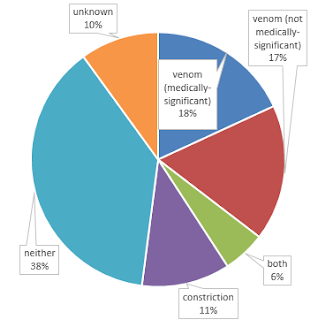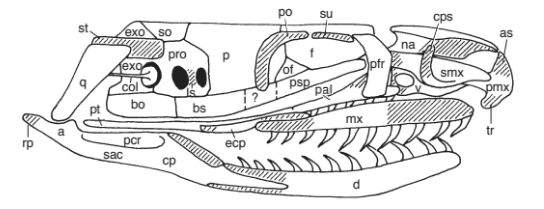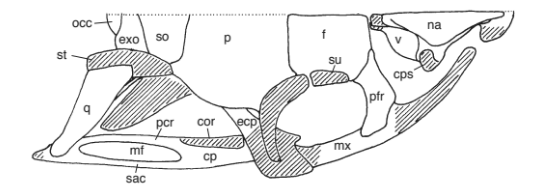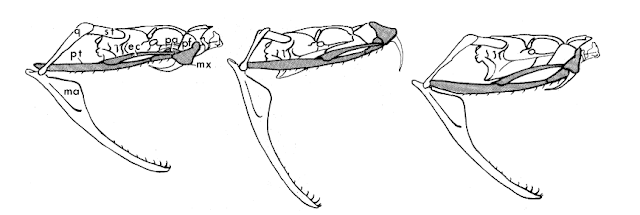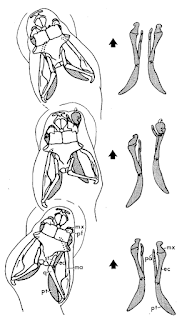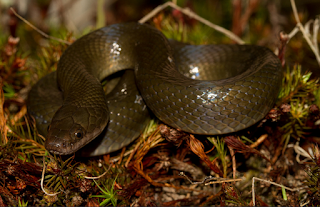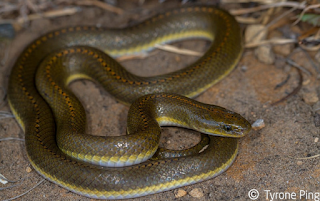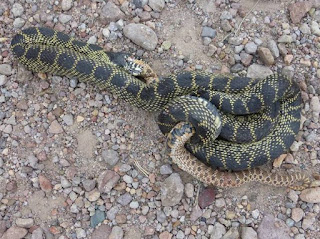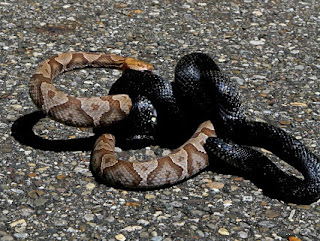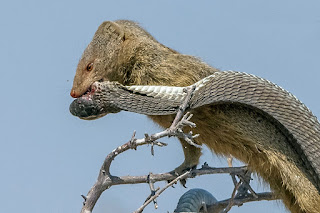I found that the answer to this question is not as simple as it may seem. Many snakes unambiguously use venom or constriction, but many use neither, and some use both! Of course the data are not as detailed or abundant as we would like. What follows is a break-down of the categories I used, and some interesting exceptions that I uncovered.
Constrictors
- Boas: 61 species, including the eponymous Neotropical Boa constrictor, anacondas (Eunectes), and smaller tree and rainbow boas (Corallus, Epicrates, Chilabothrus) as well as several (sub)families of booid snakes from various and sundry locations around the world—Candoia from New Guinea and Melanesia, sand boas (Eryx) from northeast Africa, the Middle East, and southwestern Asia, Charina and Lichanura from North America, Ungaliophis and Exiliboa from Central America, Acrantophis and Sanzinia from Madagascar, and Calabaria from tropical west-central Africa.
- Pythons: 40 species from Africa, Asia, and Australia
- Ratsnakes, kingsnakes, and close relatives: 43 species of New World colubrine colubrids in the clade Lampropeltini and their Old World counterparts, including:
- Lampropeltis kingsnakes, the consummate constrictors, which prey on other constricting snakes and are rarely, if ever, out-constricted because they are capable of exerting 20 kilopascals of pressure, twice as much as a ratsnake (average 10 kPa)
- southwestern North American species in the genera Pseudelaphe, Arizona, Rhinocheilus, Bogertophis, and Senticolis
- Pantherophis ratsnakes, as well as their sister taxon Pituophis (pine, bull, and gophersnakes), which often press their prey against rocks or other solid objects
- 2 species of live-bearing Eurasian Coronella and their close relative, the Frog-eating Rat Snake Oocatochus rufodorsatus from eastern Russia, Korea, Taiwan, and northeastern China
- 26 species of Old World Elaphe and their relatives in the genera Zamenis, Orthriophis, Oreocryptophis, Euprepiophis, and Archelaphe.
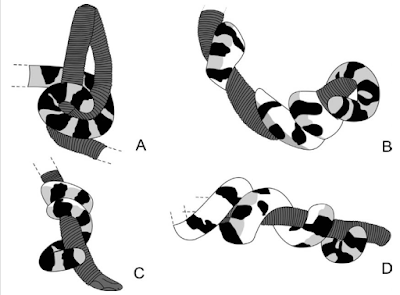 |
| Anilius scytale constricting an amphisbaenian From Marques & Sazima 1998 |
- Tropidophiids or "dwarf boas", which are not closely related to boids and certainly evolved constriction independently (34 species)
- Their close relative Anilius scytale (sort of; this snake has been observed to constrict large prey such as amphisbaenians)
- Loxocemus bicolor, the Mexican burrowing snake, a close relative of pythons
- Two speceis of Asian sunbeam snakes (genus Xenopeltis), which are also closely related to pythons
- At least some (maybe all) Asian pipesnakes (family Cylindrophiidae)
- Filesnakes (genus Acrochordus), which don't necessarily kill fish by constricting them but use their coils to hold them while they swallow
- some lamprophiine colubrids (especially the well-known African house snakes Lamprophis and Boaedon)
- the colubrine colubrid tribe Lycodontini (mostly wolf snakes, genus Lycodon)
- some snail-eating snakes (Dipsas) coil around snails as they pry them out of their shells
- even Wandering Gartersnakes (Thamnophis elegans)—sometimes! (more below)
It seems that mammal-eating is a driver of the evolution of constriction in many cases: species that eat mammals are the only members of their genera/families that use constriction (Thamnophis elegans, Boiga irregularis, Lamprophis/Boaedon, some members of the Oxyrhopus/Clelia/Pseudoboa clade) and both these and species that are nested within mammal-eating clades but have shifted to other prey (Lampropeltis extenuatum, Elaphe quadrivirgata, Cemophora coccinea1) tend to have more variable, less efficient constricting behavior that is generally only used to immobilize rather than to kill prey, if it is used at all. As Alan de Queiroz and Rebecca Groen put it: “Thamnophis elegans are not finely tuned constricting machines” and “Numerous trials in which a garter snake, holding a mouse in its jaws, was chaotically thrown about by the prey's movements support our interpretation that long constriction latencies do not reflect adaptive plasticity in T. elegans.”. Constriction probably functions to reduce the cost of feeding in terms of time, energy, and/or the probability that the prey will harm the snake.
Conspicuously not in this category, we have the poorly-named and misleading North American Racer, Coluber constrictor, which is not a constrictor (thanks for nothing, Linnaeus).
 |
| Black Mamba (Dendroaspis polylepis) eating a bird |
- Viperids(341 species), including well-known pit vipers such as rattlesnakes, copperheads, and cottonmouths
- Elapids (359 species), including coralsnakes, cobras, mambas, kraits, sea snakes, and diverse terrestrial Australian snakes ranging from death adders (genus Acanthophis) to bandy-bandys (genus Vermicella)
- Genus Atractaspis (21 species), the stiletto snakes now known to be lamprophiids, which stab backwards with their fangs, mouth closed, to envenomate prey in subterranean burrows
- Front-fanged colubrine colubrids, most notably boomslangs (Dispholidus typus), twigsnakes (genus Thelotornis), and probably their close relatives in the genus Thrasops
- some Asian natricine colubrids in the genera Rhabdophis, Macropisthodon, and Balanophis, which in addition to being (in a few cases lethally) venomous, also have the distinction of being among the only known poisonous snakes
- numerous dipsadine colubrids from the Caribbean and Central and South America, such as Xenodon, Thamnodynastes, Hydrodynastes, Coniophanes, Erythrolamprus, Rhadinaea, Leptoderia, and Apostolepis (and a few from North America, such as Heterodon and Hypsiglena)
- some colubrine colubrids (genera such as Boiga, Leptophis, Tantilla, Toxicodryas, Platyceps, Oxybelis, Hierophis, Crotaphopeltis, Drymobius, Chilomeniscus, Ficimia, and Gyalopion) as well as the Asian genera Ahaetulla and Chrysopelea, sometimes split into a different subfamily (Ahaetullinae)
- at least some natricine colubrids, such as Paratapinophis praemaxillaris and some North American gartersnakes (Thamnophis)
- many species in the family Homalopsidae,53 species of southeast Asian semi-aquatic snakes, some of which are also well-known for pulling apart large crabs and eating pieces of them
- some (maybe most) lamprophiids, including aparallactines (Amblyodipsas, Aparallactus, Micrelaps, Polemon, Xenocalamus), lamprophiines (Gonionotophis), psamophiines (Mimophis, Psammophis), and the weird genus Psammodynastes ("mock viper")
 |
| Dipsas indica coiling around a snail, from Sazima 1989 |
- Scolecophidians: Almost 450 species of blindsnakes that eat ant and termite larvae and pupae
- Uropeltids or Shield-tailed Snakes: 55 species that eat almost exclusively earthworms
- Snail-eating snakes in the family Pareidae: 20 southeast Asian species with asymmetrical jaws
- About 300 species of mostly South American dipsadine colubrids that eat soft, gooey things like slugs, snails, earthworms, or frog eggs, including:
- the most speciose genus of snakes, Atractus (currently with 140 species)
- the genus Geophis, currently in a four-way tie for the 5th-most speciose snake genus with 50 species
- some slender arboreal snakes in the genus Sibon, which crawl backward through crevices to wedge snails into them, providing an anchor against which they use their body muscles to pull out the soft parts
- Asian Thermophis
- North American Carphophis and Contia
- Most Old and New World natricine colubrids
- most gartersnakes (Thamnophis)
- watersnakes (Nerodia) and their relatives (Regina, Seminatrix, Clonophis,Tropidoclonion)
- slug-eating Storeria
- Asian ecological analogues (e.g., Amphiesma, Hebius, Opisthotropis, Xenochrophis)
- Numerous colubrine colubrids, such as:
- New World racers and coachwhips (Coluber)
- Indigo snakes (Drymarchon), which are well-known for crushing their prey in their strong jaws
- Indian ratsnakes (Ptyas)
- Egg-eating snakes (Dasypeltis), which have no need to kill the bird eggs that they eat or prevent them from escaping
- Calamariinae, an obscure subfamily of 89 species of colubrids from Asia that are thought to eat mostly earthworms
 |
| Pseudonaja textilis constricting a mouse From Mirtschin et al. 2006 |
To explain the "apparent paradox of why a species should use both venom and constriction to subdue its prey", Shine & Schwaner offered three possible non-mutually-exclusive explanations:
- The venom may be of low toxicity and thus slow to act, so holding onto the prey with either jaws or coils might allow more venom to be injected
- Species with short fangs, such as Pseudonaja, and/or that feed on on heavily armored prey , such as skinks, may use constriction to give themselves additional time to find a "chink in the armor" and envenomate their prey
- Using constriction in addition to venom may prevent snakes from losing track of bitten and envenomated prey that escape, or from being harmed by retaliating prey that are held onto
- colubrine colubrids Boiga irregularis, Macroprotodon, Platyceps gracilis, Stegonotus, Telescopus, Trimorphodon
- dipsadine colubrids from the Caribbean (Alsophis, Cubophis), Central & South America (Clelia, Helicops, Imantodes, Oxyrhopus, Philodryas, Tropidodryas, Siphlophis, Phimophis, and Pseudoboa), and North America (Diadophis, Farancia)
- the sibynophiine colubrid Sibynophis collaris
- some homalopsids, like Fordonia, Hypsiscopus, and Myron
- a few lamprophiine lamprophiids, such as Lycophidion
- pseudaspine lamprophiids Pseudaspis and Pythonodipsas
- some pseudoxyrhophiine lamprophiids Leioheterodon and Madagascarophis
- some psammophiine lamprophiids (e.g., the Montpellier Snake and its relatives in the genus Malpolon, Hemirhagerrhis, Psammophis, and Rhamphiophis)
- even Wandering Gartersnakes (Thamnophis elegans)—sometimes!
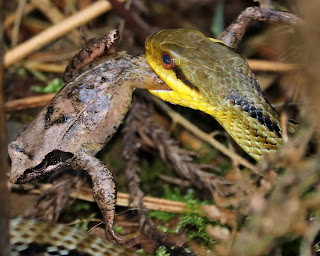 |
| Elaphe quadrivirgata not constricting a frog (Rana ornativentris) Mori (1991) showed that these snakes constrict large mice, pin small mice with a single coil, and swallow frogs alive |
- Mammals are big, or at least a lot of snakes like to eat mammals that are relatively large compared to their body size
- They are endotherms with the metabolic capacity for sustained struggling
- They can fight back with sharp teeth and strong jaws capable of seriously injuring or killing a snake, in a way that a frog or a lizard cannot
Unknown
A few examples:
- anomochilids (dwarf pipesnakes)—we don't even know what they eat
- many Malagasy pseudoyrhophiine lamprophiids (e.g., Ithycyphus, Alluaudina)
- lamprophiids from mainland Africa, such as Bothrolycus, Chamaelycus, and Dendrolycus
- obscure dipsadines—e.g., Cryophis, Tantalophis
- obscure colubrines—e.g., Bamanophis, Hemerophis
- most of the xenodermids (Fimbrios, Parafimbrios, Stoliczkia, Xylophis)
- species known only from a few specimens, like Xenophidion
 |
| Phylogenetic tree from Greene 1994 For an overview of some of the updates, click here |
1 An interesting exception are Scarletsnakes, Cemophora coccinea, the closest relatives of kingsnakes, which feed mostly on reptile eggs but also use their coils to hold lizard prey in the rare instances when they eat them. It is certain that Scarletsnakes evolved from constricting ancestors but because they almost never eat prey that need to be killed beforehand, evidently they rarely constrict.↩
2 okinavensis has been shown not to be closely related to other Ovophis, but no new genus has yet been created for it because more data are needed.↩
Andrade, R. d. O. and R. A. M. Silvano. 1996. Comportamento alimentar e dieta da "Falsa-coral"Oxyrhopus guibei Hoge & Romano (Serpentes, Colubridae). Revista Brasileira de Zoologia 13:143-150 <full-text>
Auffenberg, W. 1961. Additional remarks on the evolution of trunk musculature in snakes. The American Midland Naturalist 65:1-16 <full-text>
Bealor, M. T. and A. J. Saviola. 2007. Behavioural complexity and prey-handling ability in snakes: gauging the benefits of constriction. Behaviour 144:907-929 <ResearchGate>
de Queiroz, A. and R. R. Groen. 2001. The inconsistent and inefficient constricting behavior of Colorado western terrestrial garter snakes, Thamnophis elegans. Journal of Herpetology 35:450-460 <full-text>
Franz, R. 1977. Observations on the food, feeding behavior, and parasites of the striped swamp snake, Regina alleni. Herpetologica 33:91-94 <full-text>
Götz, M. 2002. The feeding behavior of the snail-eating snake Pareas carinatus Wagler 1830 (Squamata: Colubridae). Amphibia-Reptilia 23:487-493 <ResearchGate>
Hampton, P. M. 2011. Ventral and sub-caudal scale counts are associated with macrohabitat use and tail specialization in viperid snakes. Evolutionary Ecology 25:531-546 <link>
Holm, P. A. 2008. Phylogenetic biology of the burrowing snake tribe Sonorini (Colubridae). PhD dissertation. University of Arizona <full-text>
Jackson, K. and T. H. Fritts. 2004. Dentitional specialisations for durophagy in the Common Wolf snake, Lycodon aulicus capucinus. Amphibia-Reptilia 25:247-254 <full-text>
Loop, M. S. and L. G. Bailey. 1972. The effect of relative prey size on the ingestion behavior of rodent-eating snakes. Psychonomic Science 28:167-169 <full-text>
Martins Teixeria, D., M. Luci Lorini, V. G. Persson, and M. Porto. 1991. Clelia clelia (Mussurana). Feeding behavior. Herpetological Review 22:131-132 <link>
Mirtschin, P. J., N. Dunstan, B. Hough, E. Hamilton, S. Klein, J. Lucas, D. Millar, F. Madaras, and T. Nias. 2006. Venom yields from Australian and some other species of snakes. Ecotoxicology 15:531-538 <full-text>
Mori, A. 1991. Effects of prey size and type on prey-handling behavior in Elaphe quadrivirgata. Journal of Herpetology 24:160-166 <link>
Mori, A. and K. Tanaka. 2001. Preliminary observations on chemical preference, antipredator responses, and prey-handling behavior of juvenile Leioheterodon madagascariensis (Colubridae). Current Herpetology 20:39-49 <full-text>
Mushinsky, H. R. 1984. Observations of the feeding habits of the short-tailed snake, Stilosoma extenuatum in captivity. Herpetological Review 15:67-68 <link>
Sazima, I. 1989. Feeding behavior of the snail-eating snake, Dipsas indica. Journal of Herpetology 23:464-468 <link>
Stettler, P. H. 1959. Zur Lebensweise von Dipsas turgidus (Cope), einer schneckenfressenden Schlange. Aquarien und Terrarien 8:238-241.
